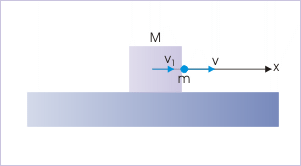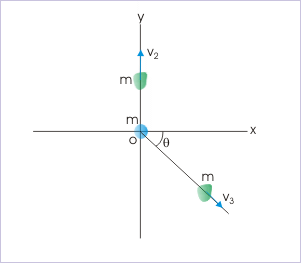| << Chapter < Page | Chapter >> Page > |
This is what is called "conservation of linear momentum". We can state this conservation principle in following two different ways.
Mathematically,
We can also state the law as :
Mathematically,
In expanded form,
We can interpret conservation of linear momentum in terms of the discussion of billiards balls. The system of billiard balls has certain linear momentum, say, "Pi", as one of the balls is moving. The ball, then, may collide with other balls. This process may repeat as well. The contact forces between the balls may change the velocities of individual balls. But, these changes in velocities take place in magnitude and direction such that the linear momentum of the system of particles remains equal to "Pi".
Momentum of a system of particles

This situation continues till one of the billiard balls strikes the side of the table. In that case, the force by the side of the table constitutes external to the system of six billiard balls. Also, we must note that when one of the ball goes into the corner hole, the linear momentum of the system changes. This fact adds to the condition for the conservation of linear momentum. Conservation of linear momentum of a system of particles is, thus, subjected to two conditions :
In short, it means that the system of particles is a closed system. The definition of the conservation principle is, thus, modified as :
Problem : A bullet of mass "m" , moving with a velocity "u", hits a wooden block of mass "M", placed on a smooth horizontal surface. The bullet passes the wooden block and emerges out with a velocity "v". Find the velocity of bullet with respect to wooden block.
Bullet piercing through a wooden block

Solution : To determine relative velocity of the bullet with respect to wooden block, we need to find the velocity of the wooden block. Let the velocity of block be " ", then relative velocity of the bullet is :
Bullet piercing through a wooden block

The important aspect of the application of conservation of linear momentum is that we should ensure that the system of particles/ bodies is not subjected to net external force (or component of net external force) in the direction of motion.
We note here that there is no external force in horizontal direction on the system comprising of bullet and wooden block. We can, therefore, find the velocity of the wooden block, using conservation of linear momentum.
and
Linear momentum is a vector quantity. It, then, follows that we can formulate conservation principle in three linear direction. In three mutually perpendicular directions of a rectangular coordinate system :
These are important result. In most of the situations, we are required to analyze motion in linear direction i.e. one direction. In that case, we are required to analyze force, momentum etc in that direction only. This is a great simplification of analysis paradigm as we shall find out in solving problems.
Problem : A ball of mass "m", which is moving with a speed " " in x-direction, strikes another ball of mass "2m", placed at the origin of horizontal planar coordinate system. The lighter ball comes to rest after the collision, whereas the heavier ball breaks in two equal parts. One part moves along y-axis with a speed " ". Find the direction of the motion of other part.
Collision of balls

Solution : Answer to this question makes use of component form of conservation law of momentum. Linear momentum before strike is :
Let the second part of the heavier ball moves with a speed " " at an angle "θ" as shown in the figure. Linear momentum in two directions after collision :
Collision of balls

Applying conservation of linear momentum :
and
Taking ratio, we have :

Notification Switch
Would you like to follow the 'Physics for k-12' conversation and receive update notifications?